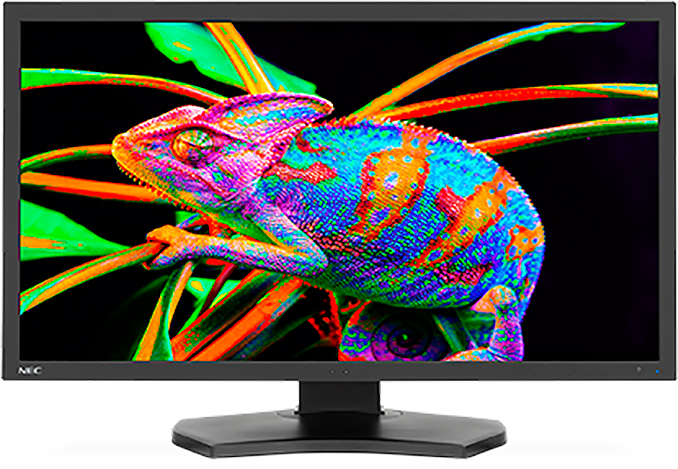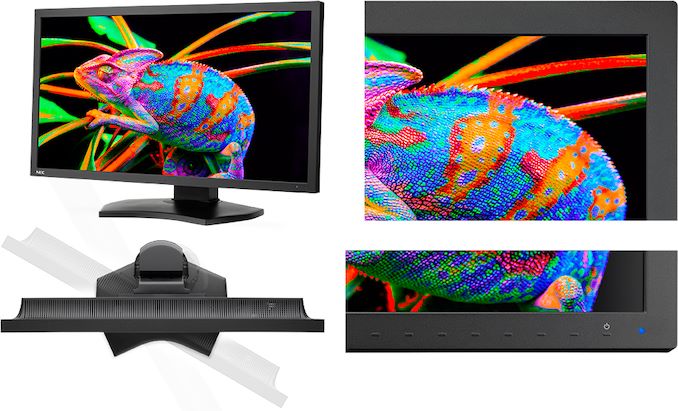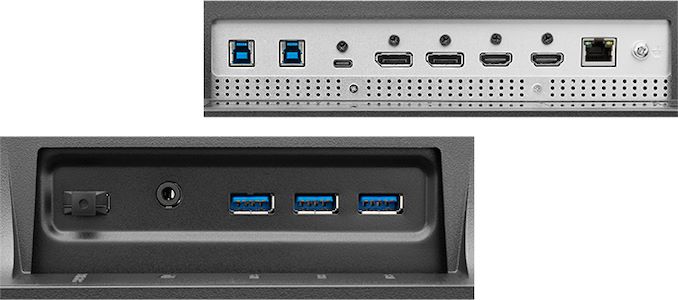NEC's MultiSync PA311D, a 10-bit IPS 4K Professional Monitor
by Anton Shilov on November 20, 2019 10:00 AM EST
NEC this week introduced a new professional display for color critical applications. The NEC MultiSync PA311D LCD features a 4K resolution, covers 100% of the AdobeRGB color space and is aimed at people working with computer graphics, video, and photography. The monitor supports sophisticated connectivity, including a USB-C input that supports 65 W power delivery.
The NEC MultiSync PA311D LCD display is based on a 31.1-inch 10-bit IPS panel with a true 4K resolution of 4096×2160. Combined with its wide gamut W-LED backlighting, that can reproduce 1.07 billion colors across 99.9% of the sRGB, 97.4% of the NTSC, and 100% of the AdobeRGB color gamuts. The monitor features a peak luminance of 350 nits, a 1400:1 contrast ratio, an 8 ms typical response time, and unusual for a pro grade monitor, a top refresh rate of 75Hz.
Being aimed at professionals, the monitor uses NEC’s custom color processor and comes with a 14-bit 3D LUT (look-up table) for color gradations. NEC has also implemented an always-on backlight sensor here, in order to offer steady colors and brightness levels. And of course, monitor calibration is supported through the company’s SpectraView II calibration software (with a color sensor sold separately or as a part of an appropriate bundle).
One unexpected capability of the monitor is that it is touch capable, and it comes with an appropriate stand that can adjust height, tilt, swivel, or change the LCD’s orientation.
The pro monitor also offers a few different input options. The monitor has two DisplayPorts, two HDMI ports, and a USB Type-C connector, the latter of which is still relatively new to professional LCDs. The USB-C port can deliver up to 65 W of power to its host PC, which is enough for most 13 and 15-inch class laptops. In addition, the display has a GbE jack, a 3.5-mm jack for headphones, and a triple-port USB 3.0 hub with two USB Type-B upstream ports.
| Specifications of the NEC MultiSync PA311D Display | |
| PA311D | |
| Panel | 31.1" IPS |
| Native Resolution | 4096 × 2160 |
| Maximum Refresh Rate | 75 Hz |
| Response Time | 8 ms |
| Brightness | 350 cd/m² (typical) |
| Contrast | 1400:1 |
| Viewing Angles | 178°/178° horizontal/vertical |
| 3D LUT | 14-bit LUT |
| Dynamic Refresh Rate | none |
| Pixel Pitch | 0.170 mm² |
| Pixel Density | 149 ppi |
| Display Colors | 1.07 billion |
| Color Gamut Support | DCI-P3: ?% Adobe RGB: 100% sRGB: 99.9% NTSC: 97.4% |
| Aspect Ratio | 1.9:1 |
| Stand | Can adjust tilt, swivel, height, and change orientation |
| Inputs | 2 × DisplayPort 2 × HDMI 2.0a/2.0b 1 × USB-C with 65 W PD |
| USB Hub | 3-port USB 3.0 hub |
| GbE | 1 × GbE |
| Launch Date | November 2019 |
NEC’s PA311D professional monitor will be available later this month directly from the company for $2,999 or $3,249 for SpectraView bundle. Besides calibration bundle, users can also get a special lighting hood for the monitor to ensure consistent color reproduction at all times and in all environments. The display is backed by a four-year warranty.
Related Reading:
- NEC Launches V554Q: A 55-Inch 4K Monitor for Professional & Signage Applications
- NEC Goes for a Curved Display, Launches 3440×1440 MultiSync EX341R Monitors
- NEC Launches Narrow Bezel MultiSync EA271U Display: 4K & USB-C Charging
- EIZO Announces ColorEdge Prominence CG3145: 4096x2160, 98% P3 and HDR10
Source: NEC












52 Comments
View All Comments
lilkwarrior - Wednesday, November 20, 2019 - link
Kinda silly to not just have a Thunderbolt 3 port vs. the 64W USB-C. Much more useful in 2019 to replace 3.1 USB-C w/ Thunderbolt 3 + the fact USB4 includes Thunderbolt 3lilkwarrior - Wednesday, November 20, 2019 - link
Appreciate the true 4K resolution, however it's super strange there's not much info about its HDR support.If it doesn't have Dolby Vision & HLG on top of HDR10, that is incredibly disappointing and this monitor wouldn't be that great for a lot of professionals accordingly (particularly video pros).I also would've hoped for HDMI 2.1 for the HDMI ports to leverage QuickSync & other affordances in addition to perhaps VRR for computer graphics work for interactive entertainment content production.
Seems 2020 is more opportune time to buy something along those lines, starting w/ the Asus PA32UCG (VRR, support for all the major HDR formats supported in film & streaming w/ only HDR10+ support TBD, 4K@120hz, Thunderbolt 3)
edzieba - Wednesday, November 20, 2019 - link
This is a pro monitor. There are two choices there: do HDR PROPERLY (i.e. either OLED or a full array backlight) or don't do it at all. Here, they've gone for don't do it at all.The half-arsed "accepts HDR inputs but only displays SDR" crap you find in the consumer space does not fly in the pro world where people often actually have a clue.
lilkwarrior - Wednesday, November 20, 2019 - link
I’m very well familiar with OLED HDR reference monitors which isn’t mandatory for a pro display as Apple & Asus proved with the Pro Display XDR & PA32UCG monitor enables (as well as dual LCD panels by the likes of Panasonic)Given the existence of those monitors—and the PA32UCX already existing pretty much the same price at ~$3800, I’m of the opinion this monitor’s feature set is questionable this late in 2019
Canam Aldrin - Saturday, November 23, 2019 - link
PA32UCX has 1D-LUTs, not 3D. For professional photographers, colorists (like myself), etc., that is a big difference. I cannot get the accuracy needed without 3D LUTs. Also, NEC has a history of serving professional image market, Asus is still trying to prove itself but hasn't yet. They've made good efforts, but the company is clearing still learning that market.Apple Pro Display XDR hasn't proven anything yet, as nobody has hands-on to evaluate it. It's also unclear if it will support 3D LUTs with 3rd-party calibration, or if it uses 3D LUTs at all. The specs just say it has a Thunderbolt input, so it's still unclear. It also costs twice the price.
umano - Monday, November 25, 2019 - link
I agree with both of you, I get both of your consumer frustration, I would like a 4k dci Dolby Vision monitor with a gamut bigger (even slightly) than Dci-P3. But It has to be color/bleeding consistent through years of usage. To my experience, even Nec cannot assure pro level consistency in 3-5 years of daily usage, except the reference models.The asus PA32UCX lacks the 4k DCI which but with 89% Rec2020 lt looks a solid option, but I do not believe it will be consistent enough to do the job. I had experience with apple monitors as well and I think it won't be much better on the long run. As many people have already said I would go for an SDR working monitor and I will check the results on an HDR 50+ inches premium TV.
I hope I am wrong and both Apple's and Asus's monitors will be amazing, but we need to wait at least a year to evaluate consistency, but luckily I do not need an HDR color grading monitor anytime soon and I can wait eizo to release a more affordable version of their 40k Prominence monitor.
andychow - Tuesday, November 26, 2019 - link
Real question: Isn't 1d-lut vs 3d-lut a software thing? If the monitor is properly calibrated, isn't lut just a transformation table that is handled in software and does not use the monitors internal tables (which I'm assuming are just there for calibration)?Death666Angel - Wednesday, November 20, 2019 - link
Not for those without a TB3 device, though.lilkwarrior - Wednesday, November 20, 2019 - link
Why wouldn’t you with a pro computing device to be used alongside this?Also USB4 has TB3, so it just doesn’t much sense to not have TB3 for the longevity this should have with the amount you’re paying for it + being a pro device.
There’s no shortage of pro devices with TB3
imaheadcase - Wednesday, November 20, 2019 - link
Because every device doesn't have thunderbolt, and every device has USB-C. Simple.